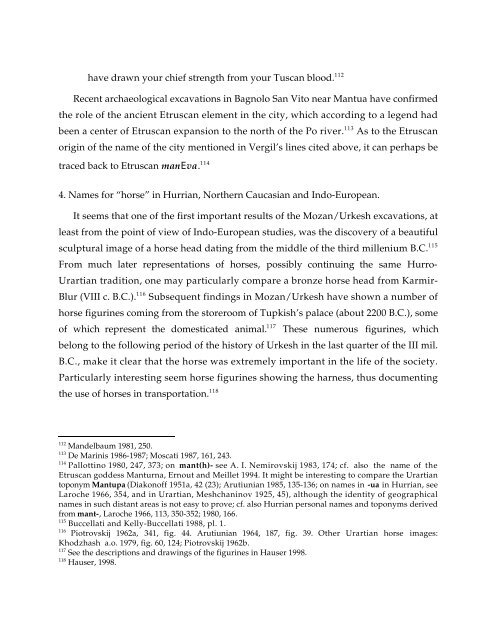Comparative Notes on Hurro-Urartian, Northern Caucasian
Comparative Notes on Hurro-Urartian, Northern Caucasian
Comparative Notes on Hurro-Urartian, Northern Caucasian
You also want an ePaper? Increase the reach of your titles
YUMPU automatically turns print PDFs into web optimized ePapers that Google loves.
have drawn your chief strength from your Tuscan blood. 112<br />
Recent archaeological excavati<strong>on</strong>s in Bagnolo San Vito near Mantua have c<strong>on</strong>firmed<br />
the role of the ancient Etruscan element in the city, which according to a legend had<br />
been a center of Etruscan expansi<strong>on</strong> to the north of the Po river. 113 As to the Etruscan<br />
origin of the name of the city menti<strong>on</strong>ed in Vergil’s lines cited above, it can perhaps be<br />
traced back to Etruscan manEva. 114<br />
4. Names for “horse” in Hurrian, <strong>Northern</strong> <strong>Caucasian</strong> and Indo-European.<br />
It seems that <strong>on</strong>e of the first important results of the Mozan/Urkesh excavati<strong>on</strong>s, at<br />
least from the point of view of Indo-European studies, was the discovery of a beautiful<br />
sculptural image of a horse head dating from the middle of the third millenium B.C. 115<br />
From much later representati<strong>on</strong>s of horses, possibly c<strong>on</strong>tinuing the same <strong>Hurro</strong>-<br />
<strong>Urartian</strong> traditi<strong>on</strong>, <strong>on</strong>e may particularly compare a br<strong>on</strong>ze horse head from Karmir-<br />
Blur (VIII c. B.C.). 116 Subsequent findings in Mozan/Urkesh have shown a number of<br />
horse figurines coming from the storeroom of Tupkish’s palace (about 2200 B.C.), some<br />
of which represent the domesticated animal. 117 These numerous figurines, which<br />
bel<strong>on</strong>g to the following period of the history of Urkesh in the last quarter of the III mil.<br />
B.C., make it clear that the horse was extremely important in the life of the society.<br />
Particularly interesting seem horse figurines showing the harness, thus documenting<br />
the use of horses in transportati<strong>on</strong>. 118<br />
112 Mandelbaum 1981, 250.<br />
113 De Marinis 1986-1987; Moscati 1987, 161, 243.<br />
114 Pallottino 1980, 247, 373; <strong>on</strong> mant(h)- see A. I. Nemirovskij 1983, 174; cf. also the name of the<br />
Etruscan goddess Manturna, Ernout and Meillet 1994. It might be interesting to compare the <strong>Urartian</strong><br />
top<strong>on</strong>ym Mantupa (Diak<strong>on</strong>off 1951a, 42 (23); Arutiunian 1985, 135-136; <strong>on</strong> names in -ua in Hurrian, see<br />
Laroche 1966, 354, and in <strong>Urartian</strong>, Meshchaninov 1925, 45), although the identity of geographical<br />
names in such distant areas is not easy to prove; cf. also Hurrian pers<strong>on</strong>al names and top<strong>on</strong>yms derived<br />
from mant-, Laroche 1966, 113, 350-352; 1980, 166.<br />
115 Buccellati and Kelly-Buccellati 1988, pl. 1.<br />
116 Piotrovskij 1962a, 341, fig. 44. Arutiunian 1964, 187, fig. 39. Other <strong>Urartian</strong> horse images:<br />
Khodzhash a.o. 1979, fig. 60, 124; Piotrovskij 1962b.<br />
117 See the descripti<strong>on</strong>s and drawings of the figurines in Hauser 1998.<br />
118 Hauser, 1998.





